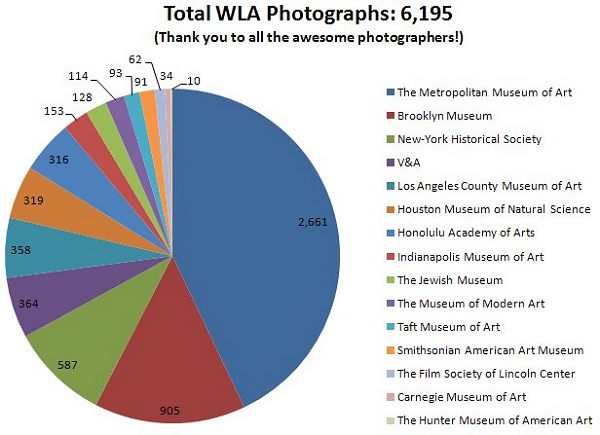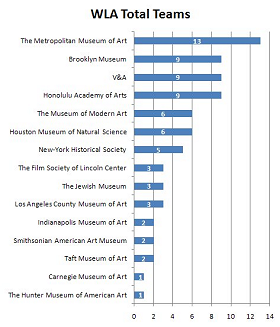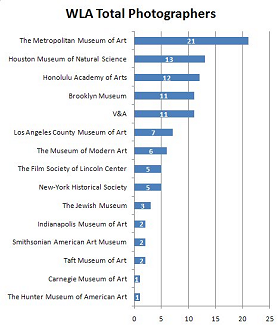Wikipedia Loves Art: Lessons Learned Part 4: The Stats
My role in Wikipedia Loves Art was solely as a processor of data. I was not involved with the creation or any of the planning of the contest. That being said, here are some project statistics as well as my experiences with the contest.

At the end of the contest there were over 13,000 images in the Flickr pool. Assuming the card/clean image ratio was 1:1, roughly 6,500 clean images were submitted. Of course, things are never that simple. Multiple views, details and other secondary images complicate estimating the original submission number.
With any submission I needed to check ten aspects of the image (1) Is the photographer registered? (2) Was the image taken in February 2009? (3) Where is the card shot? (4) Is the object on loan or (5) post-1923? [Disqualifying in most circumstances] (6) Is the image public on Flickr? (7) Does it have the right license (CC-BY or CC-BY-SA)? (8) Is it tagged? (9) Does it have a valid category tag from a goal list to which the object relates? (10) Are there any multiple views/details as secondary shots not to be scored? Perhaps some of that could have been more automated—but certainly not all of it. If that was good to go then I could manually add the machine tags to be read by our scoreboard. I could only find a few tools to help the process—it’s difficult to do batch actions to other people’s photos on Flickr.
In total, I added at least 30,000 tags since the contest began. This also included tags marking scoring issues and accession number tags. Why the accession number tags? It wasn’t part of the original tagging plan, but it became rapidly apparent it was necessary. Certainly it helps identify the object without routing around for the card, but more important it allowed me to see all the images of a given object. From the Brooklyn Museum: Four Dianas, Four cartonnages, Five scarabs, Five war councils, Six cupids, Six cats!
It makes captioning so much easier. It’s daunting however to contemplate how much of the pool is similar shots of the same objects. Further, goal lists were as also somewhat similar across all the museums, so one might end up with dozens of shots illustrating the same subject. Take Cupid for example.
Why were certain images disqualified? You can probably gather from my ten-part checklist above situations when images did not qualify. When the contest began the most common problem was forgetting of category tags, but after reminder was sent out it was rarely an issue again. Instead, it became clear the biggest problem for contest would actually be insuring the right licensing on images. Most times it seemed to be people forgetting to mark their WLA-images a different copyright than their photostream, but huge source of confusion was the necessity for a Creative Commons license which permitted commercial use and derivative works. The short answer is because the Wikimedia Commons, where the images will be stored and accessed for Wikipedia, only permits free content which can be used “by anyone for any purpose“, including potential commercial uses. There was even some worry that the Museums, in particular, would use the image for a commercial purpose. I’m not sure we made the reasoning for this licensing clear enough to our participants if concerns like this came up.
Also of note, a response I was not expecting, but was very common in disagreement with a rule, read essentially, “I am not participating for prizes, so I don’t think I need to follow this rule.” Our answer was the same rules for everyone, no exceptions. It was a frustrating situation and perhaps also required more clarity from the start.
In total, around 300 images were removed from the pool at the end of the contest due to unaddressed problems, largely incorrect licensing. What was the worst about this is it often disqualified a person’s entire contribution. How much more opportunity should we have given though to fix the problem in the context of this contest?


I don’t think it’s possible to thank the photographers enough for their work. Given my role in this project I’ve looked, literally, at every photograph submitted—often several times over. Having never been to many of participating institutions, it’s a personal reminder about the type of access an endeavor like this can offer. It’s wonderful. I would like to give special thanks though to those who went the distance, either by contributing an absurd amount of photography or by handling a particularly wonky Flickr and/or scoreboard problem. Many thanks to teams: artifacts, BWillsphotos, Department of Trife, Futons of Rock, niborean, team gene, RandomVariables, shooting brooklyn, TheAdversePossessors, The Wookies, UK FGR, Va Va Val, VeronikaB, Wiki-wiki whaaat? Also super props to The Grotto and Assignment Houston One for tying for the biggest team! And extra super props to Opal Art Seekers 4 who photographed at the most museums of any team—from London to Indianapolis!

Erin sorts and enters data for the Technology department and Digital Collections and Services. She helps upload materials to the >Flickr Commons and the >Open Collection. She also helps manage an IMLS grant which is going to help put loads of new images online in late 2009.
